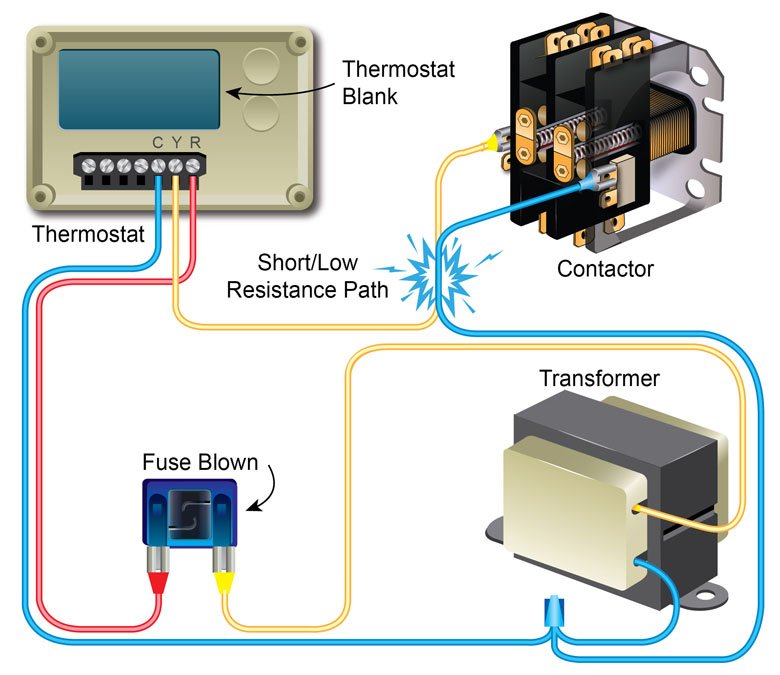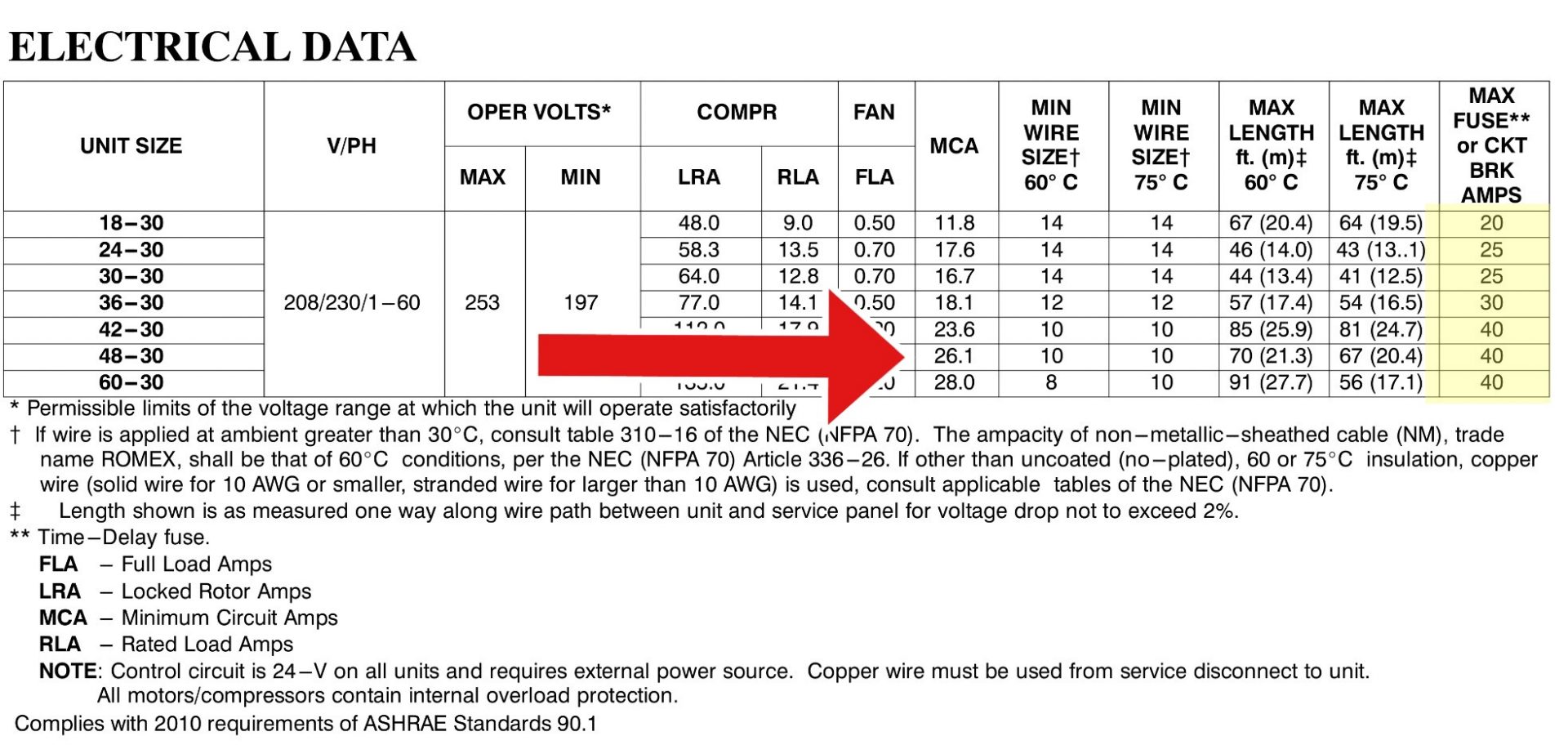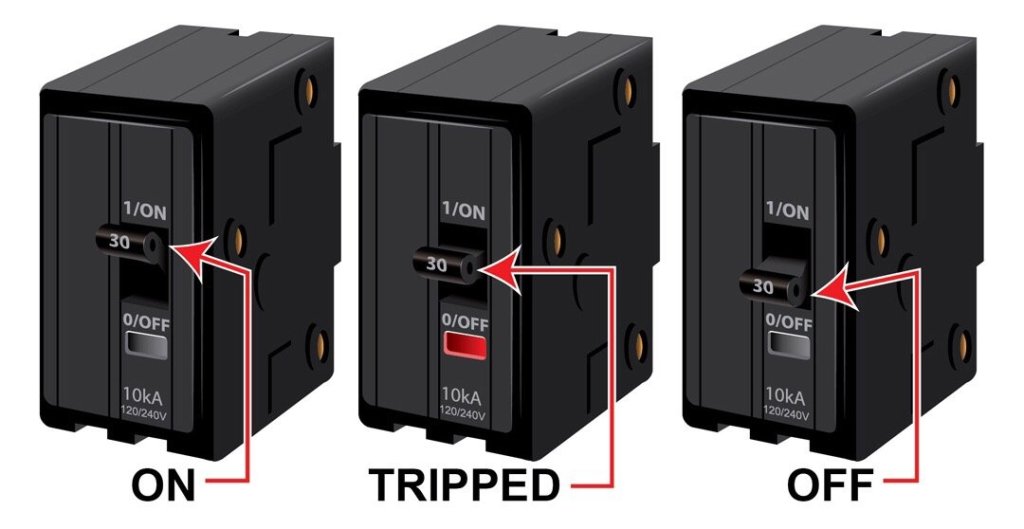Get Tech Tips
Subscribe to free tech tips.
Why Many Techs Confuse Overload, Short, & Ground Fault

The point of this article is to give you a full understanding of the role fuses, overloads, and circuit breakers play in the protection of HVAC/R equipment. If you skim-read or jump to conclusions, you will be tempted to argue. Be patient; if you want to understand, you will need to read all the way through and possibly even watch the videos at the end. This topic is WIDELY misunderstood, so the odds are that you will likely think I'm crazy when you first read it. Do your own detailed research once you get to the end if you still dispute what is contained here.
There are a few topics in HVAC/R that get widely confused and result in a lot of misinformation because of the similarity of the concepts. If you have two terms with SIMILAR meanings but get used interchangeably, you can reach completely logical-sounding (though totally incorrect) conclusions.
For example, a tech could say a particular circuit is reading “no ohms to ground,” and by that, he could mean zero ohms, or he could mean the meter is reading OL, which means infinite ohms.

In the same way, I often hear people say that something is “shorted,” and what they really mean is that it's not working or something inexplicable is happening. So, let's define some terms, starting with one of the most often confused. Here is the dictionary definition:
Short Circuit
In a device, an electrical circuit of lower resistance than that of a normal circuit, typically resulting from the unintended contact of components and consequent accidental diversion of the current.
When a professional uses the term short or short circuit, they can mean an electrical path with lower resistance than designed, or they can also mean any unintended path.

For example, if two conductors in a cable are compromised and touching one another, a tech will often say that they are shorted even if there is not a low resistance overall in the circuit.
Because of this, the term “short” has become broad and must be used carefully.
Overload
To place too much a load on
Pretty simple; when you put too much load in the bed of your truck, it bottoms out. When you place too much load on an electrical circuit or device, it fails. In the case of a conductor, this load is in the form of amperage—more amperage than designed—and the conductor will fail due to overheating.
In the case of a motor, this same thing holds true, but the actual load (opposing force) on the motor results in increased amperage load, which causes increased amperage and overheating.
That is why a compressor with failing bearings will draw higher amperage; the motor slips due to the additional mechanical load, which drops the impedance (resistance) in the motor windings, resulting in higher amperage.
Ground Fault
The momentary, usually accidental, connection of a current carrying conductor to ground or other point of differing potential
A ground fault occurs when an electrical conductor or device that is electrically charged comes in direct contact to ground or a grounded assembly or substance; this will usually result in large current spikes until either a protection device opens the circuit or the circuit itself fails open (breaks) due to heat.
I say “USUALLY ” because there are cases when a ground fault may exist with no spike in the amperage, such as when you are using an ungrounded, two-prong appliance like a hairdryer or an old drill (or a drill that you cut off the ground plug in order to use on a two-prong cord). If the internal windings on the device short to the casing, there will be no path from the casing to the ground unless something else makes a path, like, say, YOUR BODY. Then, when your hand touches the drill casing and connects to ground, some current will leak to ground through the very high resistance load that is your flesh and organs. The circuit will not “overload” because it will not be drawing abnormally high amps, but you may still die from the incident. That is why ground fault circuit interrupters (GFCIs) are used in some high-risk applications; they break the circuit when a ground fault exists, even if that ground fault does not result in an overcurrent condition.
Overcurrent Protection
A form of protection in an electrical circuit that prevents excessive current usually at a predetermined value – Usually refers to a type of protection designed to deal with instantaneous spikes in current

Over-current protection can be used as a broad term that can include circuit breakers, fuses, etc., basically anything that prevents a current from rising above a predetermined value. It CAN be a pretty broad term in some circles; HOWEVER, in the electrical community, when overcurrent protection is used, it is generally referring to short circuit or ground fault conditions.
Any condition that results in quick, massive spikes in current is addressed by overcurrent protection. I suggest reading THIS from Siemens to clarify some of the things I've just said.
Overload protection
Overload protection is a protection against a running overcurrent that would cause overheating of the protected equipment
Overload protection deals with higher current resulting from too much current being pulled by a load. When the compressor goes out on overload after one second because it is locked, that is an example of overload.
When a condenser fan goes off after running with a blade with too steep of a pitch, that is an example of overload. An overload condition in a motor is dealt with by the overload inside the motor, not by the overcurrent protection/circuit breaker/fuses. In the case of motor loads specifically, if the overload were to fail, the overcurrent protection would usually break the circuit eventually, but that is not its primary design function in most cases. Again, I recommend reading THIS from Siemens to clear things up.
NEC Guidelines and Installation Practices
When manufacturers write their system specs and print their equipment labels, they use the National Electrical Code (NEC) guidelines. They refer to articles 430 and 440 of the code to calculate the required minimum conductor size and maximum overcurrent size. That is how they come up with the MOCP, or max breaker/fuse size, and the MCA (or minimum circuit ampacity/conductor size) required.
Here is some manufacturer electrical data from a Carrier 25HCC condensing unit:

Notice the maximum breaker or fuse is 40 amps on the 4-ton, and the MCA is 26.1 with an allowable wire size of #10 on an assembly rated at 75°C and a 60°C circuit.
Yep.
On this system, it is perfectly acceptable by the National Electrical Code and the manufacturer to run #10 wire and a 40 amp breaker so long as the wire run is a properly rated copper conductor under 70 feet (on this specific unit because of the spec shown above). Wire length impacts voltage drop, which is only addressed as a suggestion in the code but is clearly laid out by the manufacturer either directly or based on the minimum voltage if you do a voltage drop calculation. In this case, the voltage must be 197v or above.
That is because the circuit breaker or fuse provides overcurrent protection (as well as some backup overload protection), and the motor overloads provide overload protection.
Now, if you would like, you are allowed to put in a lower-rated breaker than the max so long as you don't go below the MCA rating because the breaker itself also needs to handle the rated capacity. Just be aware that the lower you go, the more likely you will be to have nuisance tripping.

You can also install a larger wire if you like; just be aware that the equipment lugs may not be rated to hold/connect the larger wire in some cases. Also, keep in mind that you must also upsize the grounding conductor when arbitrarily upsizing the current-carrying conductors.
If you would like some more discussion on the topic, you can see the videos I did on this HERE, HERE, HERE, and HERE.
Finally, before you start leaving comments about what is written, please watch the two videos below. If you watch these videos, read the reference material, and STILL think that what I'm saying is false in some way, feel free to join in the conversation.
—Bryan
P.S. – Mike Holt (shown below) is a friend of mine and is considered the authority on NEC and electrical training in the US. I highly recommend watching his video covering many of the topics in this tech tip:











Comments
You did a lot of research I am impressed. This had good value. And I look forward to your tip a day!
Thanks
You did a lot of research I am impressed. This had good value. And I look forward to your tip a day!
Thanks
Nice Job!
Nice Job!
Thanks for educating me. I would say I don’t see why these points should be argued. Because I don’t. I feel they are logical and correct. But I have experience working at manufacturers and these pesky things called details are important on that side of the industry.
Thanks for educating me. I would say I don’t see why these points should be argued. Because I don’t. I feel they are logical and correct. But I have experience working at manufacturers and these pesky things called details are important on that side of the industry.
Well said and explained, I really like what you do with these hvac tips. Thanks for sharing Abroad.
Well said and explained, I really like what you do with these hvac tips. Thanks for sharing Abroad.
I’ll be honest, I took an electrical course and they didn’t even explain this as good as you did Bryan. Good job and love your work. This is by far the most educative, entertaining and self empowering podcast / website ever on hvac.
I’ll be honest, I took an electrical course and they didn’t even explain this as good as you did Bryan. Good job and love your work. This is by far the most educative, entertaining and self empowering podcast / website ever on hvac.
Bryan, This is very well explained.
Bryan, This is very well explained.
Great Presentation.
Great Presentation.
To leave a comment, you need to log in.
Log In